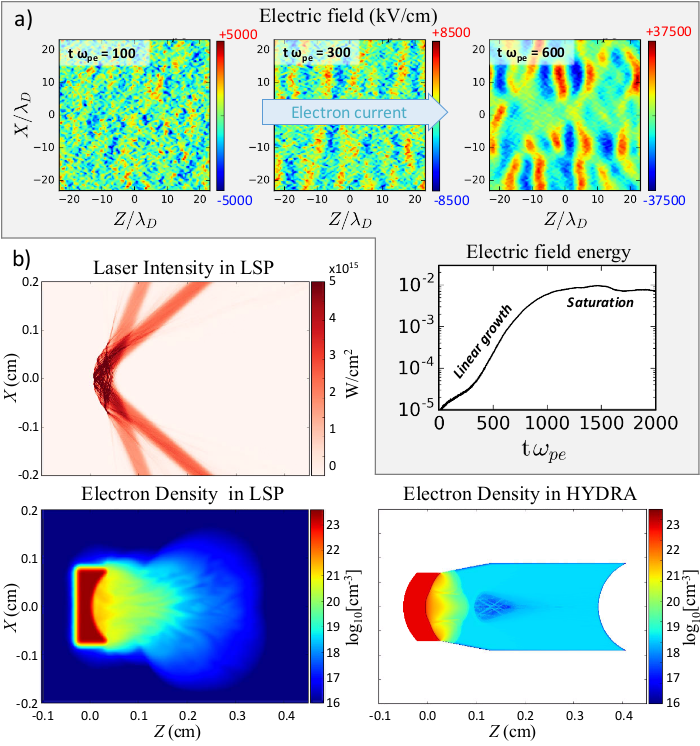Hans Rinderknecht (17-ERD-060)
Executive Summary
We are exploring the use of advanced kinetic simulation tools to understand the impact of microphysics in gas-filled laser target capsules in pursuit of Inertial Confinement Fusion. This work will improve the physics basis for predictive models and identify the most important steps for developing a higher-fidelity kinetic target-capsule simulation capability.
Project Description
Experiments on Livermore's National Ignition Facility have been investigating a range of Inertial Confinement Fusion implosion designs in the pursuit of laboratory-controlled ignition of fusion fuel imploded using an indirect-drive geometry. In this geometry, a hohlraum laser target capsule made of high-atomic-number material such as gold or uranium converts the incident laser energy into an x-ray bath that drives the implosion of the fuel target. However, simulations of hohlraum drive have not been able to accurately predict the measured hohlraum performance in experiments. We intend to study the utility of using advanced kinetic simulation tools to understand the impact of microphysics in gas-filled hohlraums. Hybrid particle-in-cell code and multiple-component hydrodynamic simulations of several problems relevant to kinetic physics in hohlraums, including two-stream instability, structure, and evolution of the target-wall blow-off plasma (composed typically of gold) and the blow-off and gas interface, could produce improved physics models of these effects for inclusion in hydrodynamic codes. We will use our simulations to design experiments for the OMEGA laser at the Laboratory for Laser Energetics in New York to benchmark models of plasma ablation and hohlraum drive. Our proposed techniques will also be benchmarked against this experimental data. This work will improve the physics basis for predictive hohlraum models and identify the most important steps for developing higher-fidelity kinetic hohlraum simulation capability.
With this effort, we expect to investigate the role of microphysics in hohlraum drive reduction by modeling hohlraums and hohlraum-relevant physics using high-fidelity kinetic simulations (see figure). Several problems relevant to hohlraum kinetic physics are accessible using the hybrid-particle-in-cell LSP code designed for large-scale plasma simulations, multicomponent hydrodynamic capability, and analytical approaches. We intend to develop improved physics models of kinetic effects, which can be included into existing hohlraum simulations. The simulation studies will support the detailed design of experiments to benchmark models of plasma blow-off and hohlraum drive and will constrain kinetic models of the ablation-front structure we develop as part of this work. These designs will utilize simple targets and geometries (e.g., planar gold foils or gas-filled, thin plastic bags used as an alternative to metal-foil targets) and will enable comprehensive diagnosis. Promising directions for further development of kinetic simulation tools will be recommended, and we will identify the most important mechanisms in hohlraums to simulate using kinetic approaches and the appropriate steps to developing that capability. In particular, the utility of rigorous n-species multicomponent models and of radiation-drive capability in the LSP code will be evaluated. These results will enable improvements in the predictive capability of hohlraum models relevant to Inertial Confinement Fusion conditions.
Mission Relevance
The development of predictive hohlraum capability is of fundamental interest for achieving ignition on the National Ignition Facility as well as for the design of other high-energy-density experiments. This project, therefore, supports the LLNL mission focus area of inertial fusion science and technology and the DOE mission in science and energy as part of the strategic objective to support an environmentally responsible, secure, and resilient U.S. energy infrastructure. Our research will provide a deeper understanding of the microphysics active in hohlraums that will inform improved physics models in hohlraum simulations. The work will also improve the physics basis for predictive hohlraum models and identify the most important steps for developing higher-fidelity kinetic hohlraum simulation capability.
FY17 Accomplishments and Results
In FY17 we (1) demonstrated the utility of hybrid particle-in-cell modeling to study microphysics in hohlraum-relevant plasmas; (2) prioritized the return-current instability (or “two-stream” instability) because of its predicted effect on symmetry in high-density carbon ignition target implosions and the lack of a physics-based benchmarked reduced-order model; (3) developed two-dimensional explicit particle-in-cell simulations with the LSP code and successfully benchmarked it against prior results; (4) increased computational speed by a thousandfold while capturing all relevant physics by identifying the resolution necessary to capture return-current instability growth rate and anomalous resistivity, demonstrating that implicit particle-in-cell methods can accurately model return-current instability growth; and (5) designed OMEGA experiments to study return-current instability using laser heating of ablated plasma in a hohlraum.
Publications and Presentations
Rinderknecht, H., et al. 2017. "The Kinetic Physics in ICF Workshop: Findings and Paths Forward." 47th Annual Anomalous Absorption Conference, Florence, OR, 11–16 June 2017. LLNL-ABS-730754.
   





